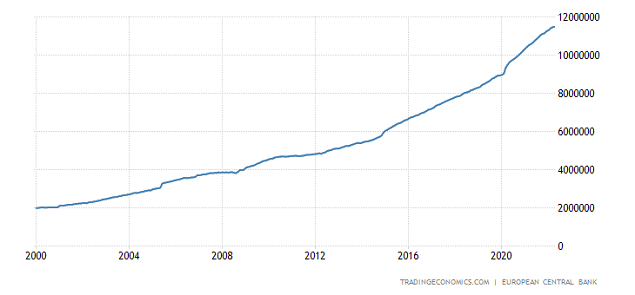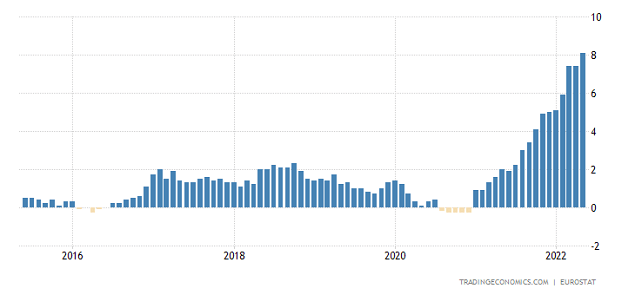What causes inflation?
Voima
Inflation in public debate
Inflation has been discussed a lot recently. And what is inflation? It means that the prices of goods and services have gone up; you could also say that inflation means the decrease in the purchasing power of money. Purchasing power decreases when, for example, the prices of gas, electricity or food increase.
The media has attributed inflation to many things: the price of petrol goes up, because oil is getting more expensive, and the price of food goes up, because raw materials such as crops and fertilisers cost more.
What the media does not talk about that often, however, is what overall causes the increase in the prices of oil, crops, fertilisers and other raw materials. In other words, the root cause of inflation has not been discussed. In this article, we will focus on the true and fundamental reasons why prices are increased.
Supply, demand and inflation
The prices of goods, services and raw materials are generally guided by supply and demand. The inflation of today has thus been tried to be explained through supply and demand. If the supply goes down but the demand remains the same, the prices will increase. Likewise, if the demand goes up but the supply does not change, the prices will increase. This also holds true the other way around.
It is true that, in the aftermath of Covid-19, the demand for goods has risen quickly, while there have been problems in the supply of goods. This in turn has raised the prices, but there is a more fundamental cause for this increase.
One variable that is typically not addressed when discussing the supply and demand function is the measure of that function, i.e. currency. Prices are measured in currencies like the euro or dollar, and so changes in the supply of currencies also affect inflation. If the supply of a currency increases, the value of the currency goes down and the prices measured in that currency will increase, even if supply and demand would remain the same.
In simple terms: when more euros are in circulation, the prices measured in euros will increase.
The amount of euros in recent years
Since 2020, central banks around the world have increased the amount of money in circulation significantly. For example, the amount of euros in circulation has risen approximately 27% during the last two years. In other words, if supply and demand are now on the same level as at the beginning of 2020, the prices could have been expected to have risen approximately 27% on average—solely due to the increase in the amount of euros.

This is not a temporary trend caused by Covid-19, because the amount of euros in circulation has increased over 570% since 2000—roughly 8.3% a year on average. This has had a significant effect on the prices of products and raw materials. In reality, money creation is the fundamental cause of inflation.
Why are more euros created?
Economists justify the increase of money in circulation by saying that more money needs to circulate as the economy grows. The economists say that if the amount of money in circulation would not grow side by side with the economy, prices could fall, which in turn would probably restrict the economic growth.
Lowering prices would also be a negative thing for those countries who have debt. If the euros that need to be paid back would increase in value compared to when they were borrowed, those countries would essentially have to pay more to their debtors. It is therefore to the advantage of the indebted countries that the value of money weakens. This is why the economists deem it a positive thing that currencies steadily lose their purchasing power.
However, the loss of purchasing power is very bad for those who are trying to save money. Even a yearly inflation rate as low as 2% would weaken the purchasing power of money by more than 45% in three decades. After 50 years, the value of one euro will have decreased by over 60%. At the moment, the yearly inflation rate in the eurozone is over 8%—at this rate, the value of euros will have decreased by 57% already in ten years' time.
Inflation is the objective of central banks, which also enables countries to get more and more debt. In reality, the inflation target of 2% that many central banks have set forces people to invest instead of saving. Investing always carries risks, so in practice central banks force people to carry risks so that people could save money for future use.
The discussion about inflation is skewed
Inflation is typically measured with a consumer price index. According to this index, the inflation rate in the eurozone is currently 8.1%—in other words, the prices affecting the lives of consumers have risen 8.1% in a year on average.
Many consumers have nonetheless experienced inflation more strongly than what the index indicates. The reason for this is that the prices of petrol, food and electricity, among other products, affect consumers differently. For example, the increase in petrol prices affects those who drive more than other consumers. The consumer price index is really a rough estimate of the impact inflation has on consumers.
Politicians and journalists have also blamed Russia for the current inflation. It is true that Russia's attack has raised the prices of raw materials. After the Russian invasion in Ukraine in February 2022, the price of natural gas has gone up by more than 100%, the price of oil more than 30% and the price of wheat in Europe approximately 30%. However, if we take a look at how raw material prices have developed from the beginning of 2020 to February 2022, we can see that the price of natural gas had already increased by over 200%, the price of oil by over 60% and the price of wheat by more than 60% before the Russian invasion.
Even though the Russian invasion has increased prices, this is not the fundamental cause of today's inflation. The eurozone inflation rate was already at 5.1% when the invasion began in February 2022. Back then, the rate was the highest the eurozone had ever seen, yet it pales in comparison with the more recent figures:

The fundamental cause for price increases
It is the deliberate aim of central banks that purchasing power decreases. This is the fundamental cause of inflation, which is often left unmentioned in public debate. There are naturally other factors involved, but inflation is accelerated by design by increasing the amount of money in circulation. This means that, at the end of the day, it is the citizens that pay the bill caused by inflation—through lost purchasing power.
